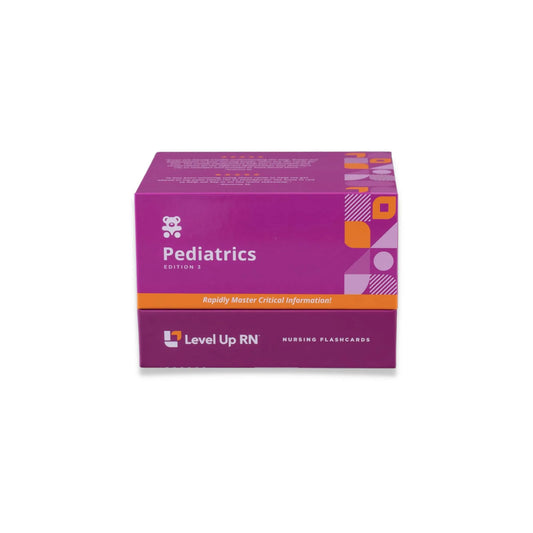Hi, I'm Cathy with Level Up RN. In this video, I am going to wrap up my coverage of childhood cancers from our Level Up RN Pediatric Nursing flashcards. Specifically, I'll be talking about leukemia and lymphoma. And at the end of the video, I'm going to give you guys a little quiz to test your understanding of some of the key points I'll be covering. So definitely stay tuned for that. And if you have our flashcards, go ahead and pull out your flashcards on leukemia and lymphoma so you can follow along with me.
Leukemia is the most common pediatric cancer. It causes the overgrowth of abnormal and immature white blood cells in the bone marrow, which in turn prevents the growth of red blood cells, platelets, and normal white blood cells. So because the child will have a decrease in red blood cells, they will have signs and symptoms of anemia such as pallor, fatigue, and shortness of breath. And because the child will have a decrease in platelets, they will have signs and symptoms such as abnormal bleeding and bruising. And then because the child will have a decrease in normal white blood cells, they will have signs and symptoms such as fevers and frequent infections. And then other signs and symptoms of leukemia include joint and bone pain as well as decreased appetite.
In terms of diagnostic studies, a CBC will show a decrease in red blood cells and platelets and an increase in blasts, which are immature white blood cells. So as the nurse caring for a patient with leukemia, you will need to prevent infection due to the presence of neutropenia and prevent bleeding due to the presence of thrombocytopenia. In terms of diagnosis, leukemia would be definitively diagnosed with a bone biopsy, and then a lumbar puncture may be ordered as well to check for the spread of cancer to the central nervous system.
Treatment of leukemia includes chemotherapy, radiation, targeted therapy, as well as a stem cell transplant.
Let's now talk about lymphoma, which is cancer of the lymphatic system. With this type of cancer, lymphocytes mutate into cancerous cells that multiply and crowd out normal white blood cells. The two main types of lymphoma are Hodgkin's and non-Hodgkin's lymphoma. So let's talk about the key differences between those two types.
Hodgkin's lymphoma is less common than non-Hodgkin's lymphoma. With Hodgkin's lymphoma, we have the presence of Reed-Sternberg cells, which are large abnormal lymphocytes. With non-Hodgkin's lymphoma, these cells are not present. Hodgkin's lymphoma typically starts in the lymph nodes of the chest, neck, or armpits, and then spreads in a predictable way, making it easier to detect and treat. This is different than non-Hodgkin's lymphoma, which may arise in various parts of the body, which makes it harder to detect and treat. Both types of lymphoma have similar signs and symptoms, which include lymphadenopathy, fever, night sweats, fatigue, shortness of breath, decreased appetite, and weight loss.
Lymphoma would be diagnosed with a biopsy of a lymph node as well as a bone marrow biopsy. And then imaging such as a CT, MRI, or PET scan will be ordered to check for the spread of lymphoma to other parts of the body.
Treatment options include chemotherapy, radiation, targeted therapy, immunotherapy, as well as a stem cell transplant.
All right, it's quiz time, and I've got three questions for you.
Question number one. How are red blood cells, normal white blood cells, and platelets affected by leukemia?
The answer is, they will all be decreased.
Question number two. Why would a patient with leukemia exhibit pallor and fatigue?
The answer is, due to the presence of anemia.
Question number 3. Reed-Sternberg cells are present in which type of lymphoma?
The answer is Hodgkin's lymphoma.
All right, that's it for this video. I hope it was helpful. Take care, and thank you so much for watching.
[BLOOPERS]
You will need to prevent infection due to.


